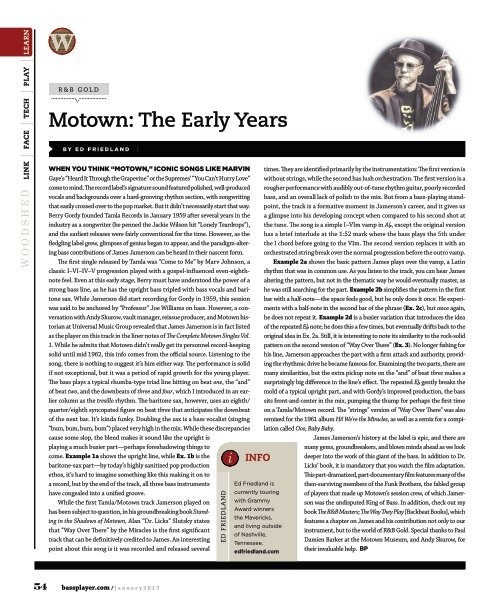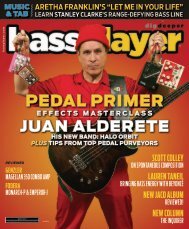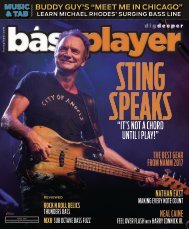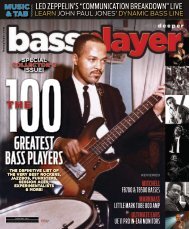BassPlayer 2017-01
BassPlayer 2017-01
BassPlayer 2017-01
You also want an ePaper? Increase the reach of your titles
YUMPU automatically turns print PDFs into web optimized ePapers that Google loves.
WOODSHED LINK FACE TECH PLAY LEARN<br />
W<br />
R&B Gold<br />
Motown: The Early Years<br />
By Ed Friedland |<br />
When you think “Motown,” iconic songs like Marvin<br />
Gaye’s “Heard It Through the Grapevine” or the Supremes’ “You Can’t Hurry Love”<br />
come to mind. The record label’s signature sound featured polished, well-produced<br />
vocals and backgrounds over a hard-grooving rhythm section, with songwriting<br />
that easily crossed over to the pop market. But it didn’t necessarily start that way.<br />
Berry Gordy founded Tamla Records in January 1959 after several years in the<br />
industry as a songwriter (he penned the Jackie Wilson hit “Lonely Teardrops”),<br />
and the earliest releases were fairly conventional for the time. However, as the<br />
fledgling label grew, glimpses of genius began to appear, and the paradigm-altering<br />
bass contributions of James Jamerson can be heard in their nascent form.<br />
The first single released by Tamla was “Come to Me” by Marv Johnson, a<br />
classic I–VI–IV–V progression played with a gospel-influenced even-eighthnote<br />
feel. Even at this early stage, Berry must have understood the power of a<br />
strong bass line, as he has the upright bass tripled with bass vocals and baritone<br />
sax. While Jamerson did start recording for Gordy in 1959, this session<br />
was said to be anchored by “Professor” Joe Williams on bass. However, a conversation<br />
with Andy Skurow, vault manager, reissue producer, and Motown historian<br />
at Universal Music Group revealed that James Jamerson is in fact listed<br />
as the player on this track in the liner notes of The Complete Motown Singles Vol.<br />
1. While he admits that Motown didn’t really get its personnel record-keeping<br />
solid until mid 1962, this info comes from the official source. Listening to the<br />
song, there is nothing to suggest it’s him either way. The performance is solid<br />
if not exceptional, but it was a period of rapid growth for the young player.<br />
The bass plays a typical rhumba-type triad line hitting on beat one, the “and”<br />
of beat two, and the downbeats of three and four, which I introduced in an earlier<br />
column as the tresillo rhythm. The baritone sax, however, uses an eighth/<br />
quarter/eighth syncopated figure on beat three that anticipates the downbeat<br />
of the next bar. It’s kinda funky. Doubling the sax is a bass vocalist (singing<br />
“bum, bum, bum, bum”) placed very high in the mix. While these discrepancies<br />
cause some slop, the blend makes it sound like the upright is<br />
playing a much busier part—perhaps foreshadowing things to<br />
come. Example 1a shows the upright line, while Ex. 1b is the<br />
i<br />
baritone-sax part—by today’s highly sanitized pop production<br />
ethos, it’s hard to imagine something like this making it on to<br />
a record, but by the end of the track, all three bass instruments<br />
have congealed into a unified groove.<br />
While the first Tamla/Motown track Jamerson played on<br />
has been subject to question, in his groundbreaking book Standing<br />
in the Shadows of Motown, Alan “Dr. Licks” Slutsky states<br />
that “Way Over There” by the Miracles is the first significant<br />
track that can be definitively credited to James. An interesting<br />
point about this song is it was recorded and released several<br />
ED FRIEDLAND<br />
INFO<br />
Ed Friedland is<br />
currently touring<br />
with Grammy<br />
Award winners<br />
the Mavericks,<br />
and living outside<br />
of Nashville,<br />
Tennessee.<br />
edfriedland.com<br />
times. They are identified primarily by the instrumentation: The first version is<br />
without strings, while the second has lush orchestration. The first version is a<br />
rougher performance with audibly out-of-tune rhythm guitar, poorly recorded<br />
bass, and an overall lack of polish to the mix. But from a bass-playing standpoint,<br />
the track is a formative moment in Jamerson’s career, and it gives us<br />
a glimpse into his developing concept when compared to his second shot at<br />
the tune. The song is a simple I–VIm vamp in Ab, except the original version<br />
has a brief interlude at the 1:52 mark where the bass plays the 5th under<br />
the I chord before going to the VIm. The second version replaces it with an<br />
orchestrated string break over the normal progression before the outro vamp.<br />
Example 2a shows the basic pattern James plays over the vamp, a Latin<br />
rhythm that was in common use. As you listen to the track, you can hear James<br />
altering the pattern, but not in the thematic way he would eventually master, as<br />
he was still searching for the part. Example 2b simplifies the pattern in the first<br />
bar with a half-note—the space feels good, but he only does it once. He experiments<br />
with a half-note in the second bar of the phrase (Ex. 2c), but once again,<br />
he does not repeat it. Example 2d is a busier variation that introduces the idea<br />
of the repeated Eb note; he does this a few times, but eventually drifts back to the<br />
original idea in Ex. 2a. Still, it is interesting to note its similarity to the rock-solid<br />
pattern on the second version of “Way Over There” (Ex. 3). No longer fishing for<br />
his line, Jamerson approaches the part with a firm attack and authority, providing<br />
the rhythmic drive he became famous for. Examining the two parts, there are<br />
many similarities, but the extra pickup note on the “and” of beat three makes a<br />
surprisingly big difference in the line’s effect. The repeated Eb gently breaks the<br />
mold of a typical upright part, and with Gordy’s improved production, the bass<br />
sits front-and-center in the mix, pumping the thump for perhaps the first time<br />
on a Tamla/Motown record. The "strings" version of "Way Over There" was also<br />
remixed for the 1961 album Hi! We're the Miracles, as well as a remix for a compilation<br />
called Ooo, Baby Baby.<br />
James Jamerson’s history at the label is epic, and there are<br />
many gems, groundbreakers, and blown minds ahead as we look<br />
deeper into the work of this giant of the bass. In addition to Dr.<br />
Licks’ book, it is mandatory that you watch the film adaptation.<br />
This part-dramatized, part-documentary film features many of the<br />
then-surviving members of the Funk Brothers, the fabled group<br />
of players that made up Motown’s session crew, of which Jamerson<br />
was the undisputed King of Bass. In addition, check out my<br />
book The R&B Masters; The Way They Play [Backbeat Books], which<br />
features a chapter on James and his contribution not only to our<br />
instrument, but to the world of R&B Gold. Special thanks to Paul<br />
Damien Barker at the Motown Museum, and Andy Skurow, for<br />
their invaluable help. BP<br />
54 bassplayer.com / january<strong>2<strong>01</strong>7</strong>






